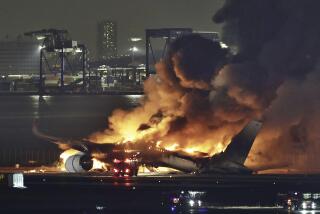Aircraft Safety and the FAA
- Share via
Regarding your reporting on aircraft safety (“Dangerous Delays,” Dec. 11-13): I couldn’t agree with you more. It’s the legal cost of human life versus the cost of the safety measure. As an aircraft engineer, I researched the use of jelled fuels as a safety measure for fighter aircraft many years ago. I found extensive research showing that in a crash with ruptured fuel tanks, the jelled fuel did not atomize and ignite as does conventional jet fuel. Rather it remained in globs and, if it did ignite, burned calmly like Sterno.
Would you believe the Federal Aviation Administration funded research, including the operation and crash of a DC-9, and proved its feasibility? The catch was that you make jelled fuel by adding 2% water--which means the airlines would lose 2% of their payload. Therefore the conclusion was that it was not cost-effective to switch to jelled fuel to save lives, because the value of the potential number of lives saved in the infrequent crashes was worth less than the day-in, day-out payload loss. I guess insurance is cheaper.
Until a human life is considered priceless, business considerations will rule when it comes to aircraft safety.
WALT KELLER
Malibu
* An impression is left by your writers that the FAA has failed to exercise due diligence in its obligation to set safety standards on a timely basis. While I’m not a particular advocate of the FAA, their role must be understood to place them in the proper context. Federal law empowers the FAA to establish (and enforce) minimum standards for the safe operation of aircraft. These standards are the minimum standards below which an aircraft may not be operated.
The law further provides that airline aircraft must be operated with the “highest degree of care.” It is at this stage where the dedication to airline safety faces its true test. Responsible air carriers have woven procedures into their air and maintenance operations, which carry a margin of safety beyond that demanded by the FAA.
The Dec. 12 article seemed to censure the FAA for its presumed lack of initiative in demanding that commuter aircraft be equipped with “ground proximity warning systems.” Where were the commuter operators in this picture? If GPWS is such a sure-fire road to commuter airline safety, why haven’t commuter airline managers installed these devices without outside urging? The same comment is applicable to the Dec. 13 article regarding ground anti/de-icing. The dangers inherent in ice accumulation on aircraft lifting surfaces have been known for at least 75 years.
I am not an employee of the FAA. Far from it. I spent nearly 40 years as an airline pilot and retired from my company, the largest in the free world, as head of its flight operations department.
W. E. DUNKLE
Camarillo
* Your article, “FAA Must Strike Balance Between Safety, Cost Issues,” (Dec. 12) struck a chord with me since I have been an FAA-licensed aviation maintenance professional since 1970.
Air travelers should be grateful each accident doesn’t create a knee-jerk reaction mandating expensive remedies, since all costs are eventually passed onto those paying the tariff. Airlines generally will not install safety equipment unless directed by FAA mandate. This is understandable since few businesses are willing to voluntarily incur large expense when regulations are already in place to prevent aircraft and ground collisions, to use your example. More regulations do not safety make.
STEVE ELLS
Santa Maria
More to Read
Inside the business of entertainment
The Wide Shot brings you news, analysis and insights on everything from streaming wars to production — and what it all means for the future.
You may occasionally receive promotional content from the Los Angeles Times.










